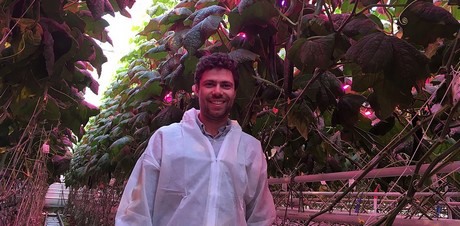To adjust the plant load to the light supply, we need to empty more nodes, wrote Tristan Marcel Balk in his previous update about the 'De Groenste Komkommer' (The Greenest Cucumber) project in December. After this, the follow-up and swelling of the fruits has not improved. The fruits at the top of the head have been assessed throughout the winter as strongly flowering fruits and there is no indication that the same fruits are 'forgotten' by the plant later.
As the fruits get lower in the plant, 20 to 30% of the fruits do not swell. The non-swelling fruits are harvested as waste with hardened and dried points. "Since then we have excluded possible causes to find out what could be the cause of the fruit not swelling."
Looking for cause of swelling fruit
The aim of the trial was to produce year-round climate-neutral cucumbers with a production of 3 kg / m2 / week, to make the cultivation of cucumbers profitable in the darkest winter period. "On average we achieved a production of 2 kg / m2 / week. After the experience that this did not work out as expected, we soon discovered that the solution does not lie in adaptations to the climate strategy. We have set aside the energy objectives and therefore the use of active dehumidification, to first show that with a conventional cultivation method the cucumbers did not grow better. "
It was stated in the BCOs that it could be due to the water intake of the plant. If too little water is given, the plant can extract water from the fruits, then the fruit "petrifies" and no longer swells. "With a watering strategy we have been able to maintain a good quality root system without infection of Pythium so far. The water intake has been improved with adjustments in watering from 2.5 cc / joule (120 cc / mol) in week 50 to 3.5 cc / joule (140 cc / mol) in week 52, where it was on average 3.7 cc / joule (164 cc / mol) in the first 10 weeks of 2019. But there was no improvement in the follow-up and swelling of the fruits. "
Ethylene influence
Through the use of active dehumidification, the vents remain more closed in the exposed period. To gain insight into any side effects on the crop, three EMS flue gas measuring posts were installed in the trial. Measurement has been taking place at the Improvement Center (IC) within the cucumber department since the start of the test. To investigate further influences, two extra measuring posts were placed in weeks 8 and 9, one outside at the IC and one inside at a cucumber grower that uses Son-T lighting and pure CO2 dosing.
At the end of December and mid-January, high concentrations of flue gases were measured at the IC in the greenhouse, but also at growers in the vicinity of Bleiswijk. Measurements from the Royal Netherlands Meteorological Institute that have measuring poles outside, spread across the country, show that the same trend in flue gas concentrations took place during the same period. During those same periods it was cold outside and there was a south to southwest wind.
In February the concentrations of ethylene at the cucumber grower were on average higher than the effect limit value of 11 ppm. During that period cucumbers were produced without problems at the cucumber grower. At the IC, the average ethylene concentration was lower than the effect limit value, but higher than the outside values.
Due to colder weather more heating is needed, which may explain the decrease in air quality outside. When the air quality outside decreases, this automatically influences the air quality inside the greenhouse. Closing air vents in those periods can only prevent to a limited extent that the air quality in the greenhouse also decreases. In greenhouses there is always a degree of ventilation even when the windows are closed. The origin of the exceptionally high flue gas concentrations in the December and January periods in the greenhouse has thus been explained.
In addition, a cucumber crop can also produce ethylene itself up to concentrations that exceed the effect limit value, whereby excellent cucumbers can nevertheless be produced. "It seems that ethylene has had no influence on the production of the cucumber crop."
Influence of artificial light
"With the decrease of the outside light to winter, we have seen the crop change with leaves that curl to the extreme and fruits that do not swell. The cucumber crop may experience a shortage of a certain light color that in the sunlight is in the right proportions. In order to make LED in cucumber succeed under low daylight conditions, an optimization in the light spectrum may be needed."
With the light sources present in the test, three light treatments were started at the beginning of February to provoke a reaction to crop development. "In combination with additional crop measurements, we hope to gain more insight into why the crop grows differently and how the plant responds to physiological processes under the different light conditions. In short, there is still much to be learned before cucumbers can be grown all year round."
Source: Kas als Energiebron
